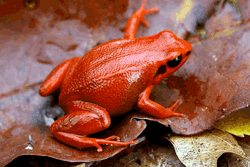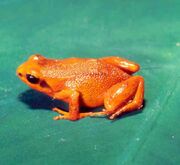| Black-eared Mantella | |
|---|---|
 | |
| Physical description | |
| Binomial name | Mantella milotympanum |
| Habitat | Tropical rainforest |
| Lifespan | 8-12 years |
| Average Size | 2.5-3.0 cm (1.0-1.2 in) |
| Average weight | 1.4-2.75 grams |
| Diet | Insectivorous |
| Conservational Status | |
| Status | Critically endangered |
| IUCN status | 3.1 |
| Scientific classification | |
| Kingdom | Animalia |
| Phylum | Chordata |
| Class | Amphibia |
| Order | Anura |
| Family | Mantellidae |
| Genus | Mantella |
| Species | M. milotympanum |
| Distribution | |
| Distribution of species | Southeastern Madagascar |
The Black-eared Mantella, Mantella milotympanum, is a species of average to large-sized Mantella native to northeastern Madagascar. It is a highly toxic species, and is brightly coloured to advertise its toxicity. It is thought to be the sister taxon of M. aurantiaca. It is threatened by habitat loss and chytridiomycosis. It is occasionally kept as a pet by herpetoculturists.
Poison[]
The black-eared Mantella is less-toxic than the similar Golden Mantella, but still a highly toxic animal. Its skin secretes pumiliotoxin A, the most toxic of the three pumiliotoxin types. Pumiliotoxin A, like other pumiliotoxins, functions by blocking muscle contractions, which can cause cardiac arrest and respiratory failure. P. lugubris contains a surprisingly high amount of pumiliotoxin for a frog of its size; thus touching a wild specimen can have serious and possibly life-threatening consequences.
Pumiliotoxin is deadly in high concentrations. Pumiliotoxin is weaker than allopumiliotoxin and especially batrachotoxin, with a lethal dose of 2 mg (P. lugubris carries about three-quarters of a milligram). There are three different types of this toxin A, B and C. Toxins A and B are significantly more toxic than C. Pumiliotoxins affect the body because they interfere with muscle contraction in the heart and skeletal muscle. The toxin works by affecting the calcium channels. Some of the symptoms of pumiliotoxins are partial paralysis, having difficulty moving, being hyperactive and in some cases it can result in death.
Description[]

Wild specimen, approximately 3 metres from the ground.
Mantella milotympanum is a medium to large-sized Mantella. Males are typically around 2.75 centimetres in length, while the females are larger and can reach 3.0 centimetres long. As with other Mantellas, female black-eared Mantellas are also more robust than the slender and elegant males; however, the difference in size and shape can be minimal.
M. milotympanum is one of the most variable known Mantellas. All examples have a dark tympanum, a pointed snout, gracile front legs, and robust hind legs. They are similar in appearence to Mantella aurantiaca, but have more granular skin and are much more variable in colouration. Some individuals are entirely red or reddish brown, others are orange or bronze, and a few are yellow or yellowish-green. The reason for this variation is unknown, although it may play a role in sexual selection as in Oophaga pumilio.
Like most Mantellas, the black-eared Mantella is a primarily terrestrial frog, climbing only when it absolutely needs to.
Behaviour[]

Wild specimen in Madagascar.
The black-eared Mantella one of the most intelligent anurans known. It can distinguish between humans, and it is capable of remembering locations that suit it well weeks after visiting them.
Mantella milotympanum is a communal frog, living in small groups of interacting individuals. These groups are not territorial, and family groups of black-eared Mantellas may live alongside one another. During the breeding season Mantella milotympanum become territorial and aggressive, but during the majority of the year they are not excessively so.
Reproduction[]
The black-eared Mantella has a similar reproductive cycle to most other Mantellas. At the beginning of the rainy season, gatherings of M. milotympanum gather around suitable breeding sites. As the rain starts falling, males begin to call to females with a sound that has been described as like pebbles clicking together. Males will grapple with one another to clear small breeding spaces, and females wander among the males. Larger and more powerful males are more popular among females, and females may also grapple to mate with a single male. Once a pair has joined, the male leads the female to a vertical surface such as a tree trunk or a boulder. The female lays her eggs on the vertical surface, and the male then fertilizes them. They are then guarded by the male, who will protect the eggs and moisten them with his own urine. When the eggs hatch, the tadpoles form a tight ball around the waist of their father, who carries them to a puddle on the forest floor and guards them until their development is complete. The froglets are then led by the male to an existing group
In Captivity[]

Two specimens in captivity.
In captivity, M. milotympanum are bold and quite showy for such a small frog. Males call relentlessly after heavy misting, and unlike many other species, females seem to be fairly outgoing as well. They will excavate tiny burrows beneath driftwood, piles of moss, and dried leaves, where females deposit eggs. Cool temperatures are necessary to maintain this species. Avoid those above 26°C (79°F) to prevent heat stress. During a simulated dry season, the temperature can fall as low as 15°C (59°F) without problems.